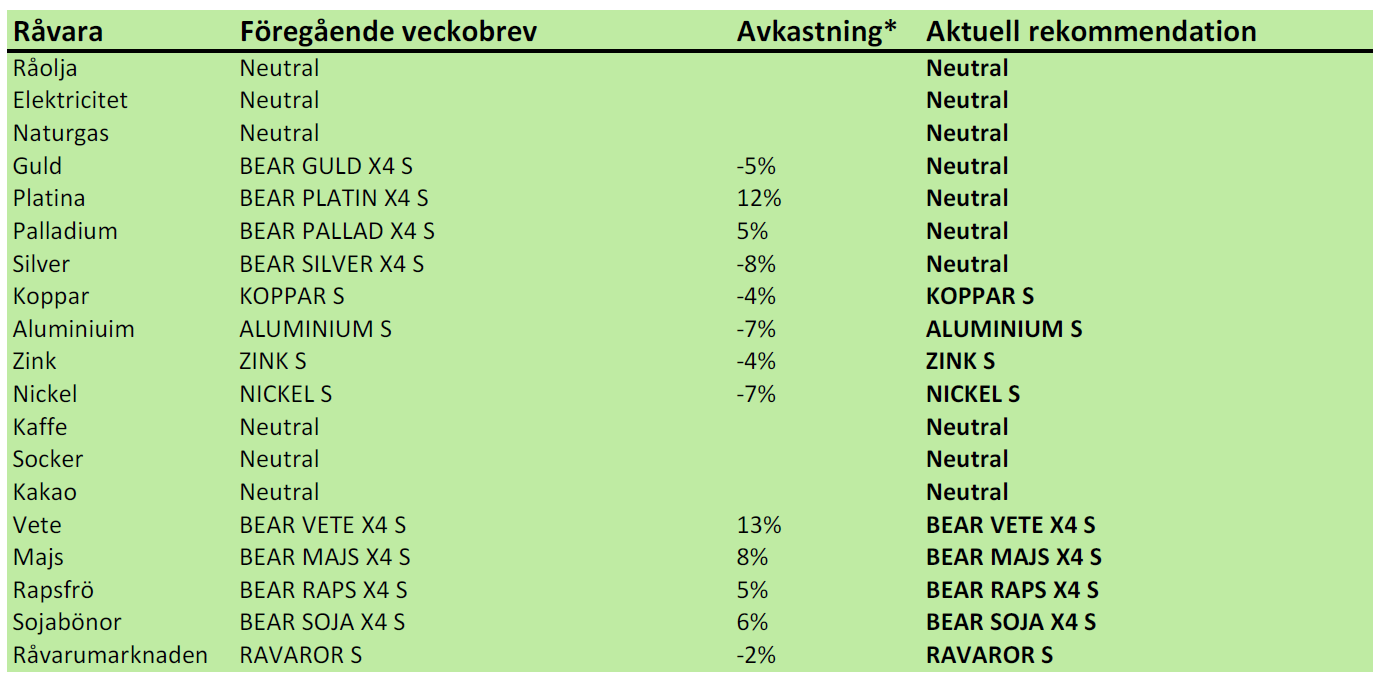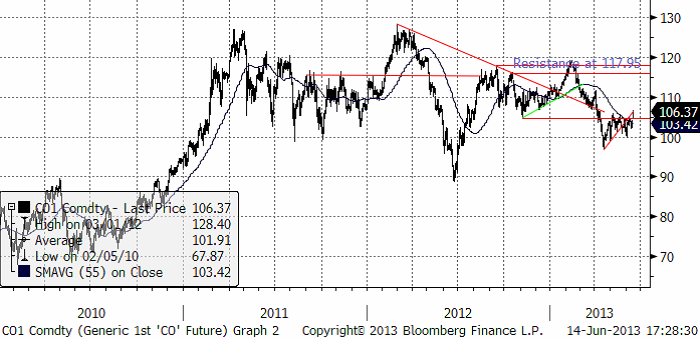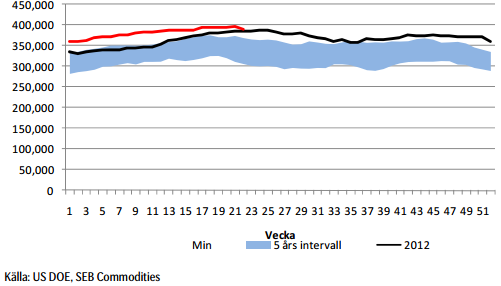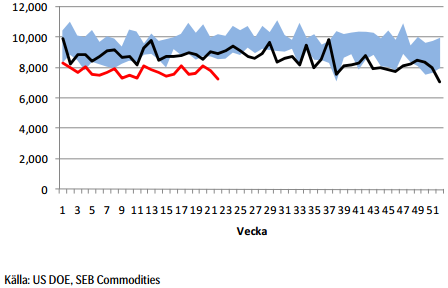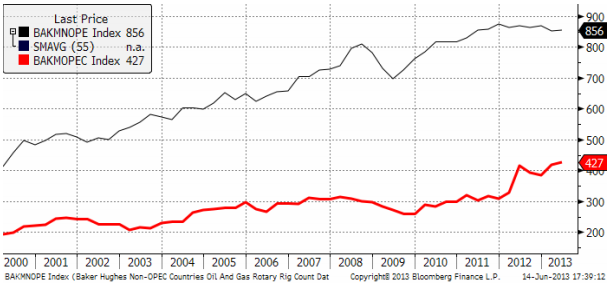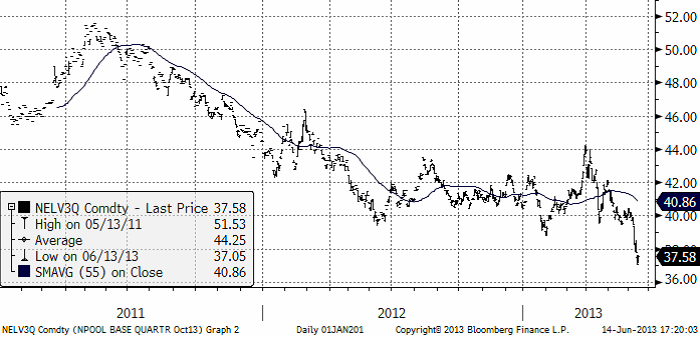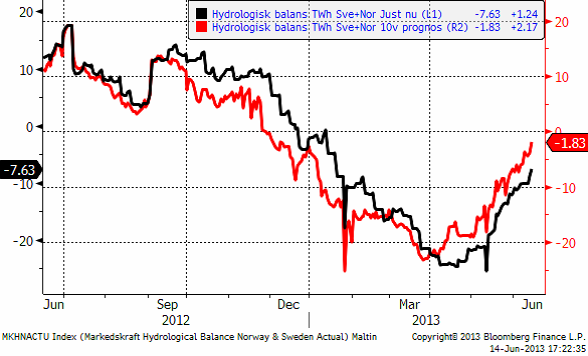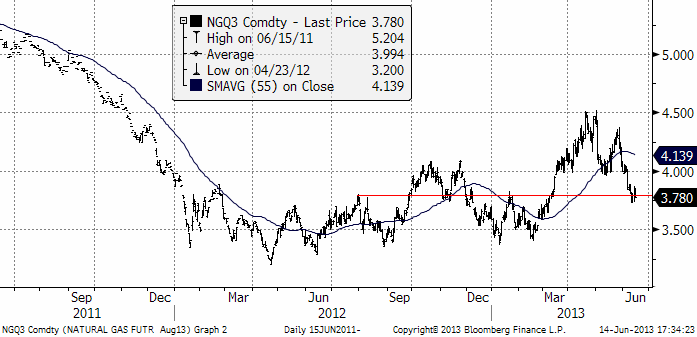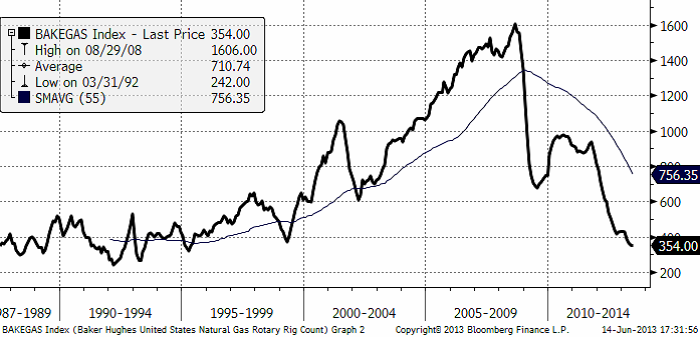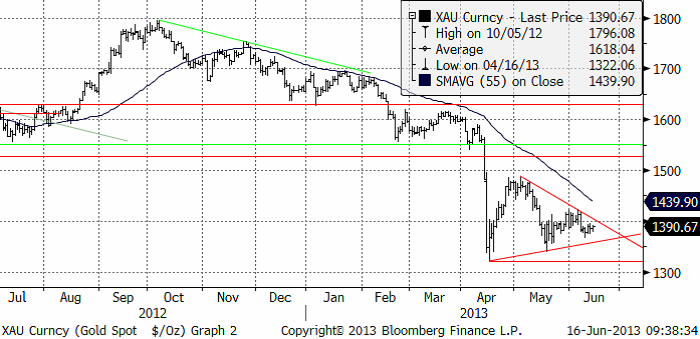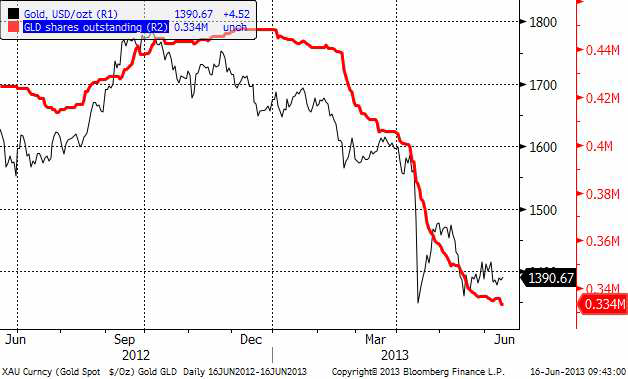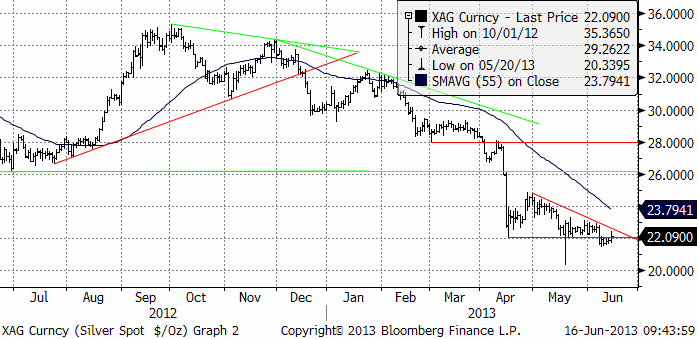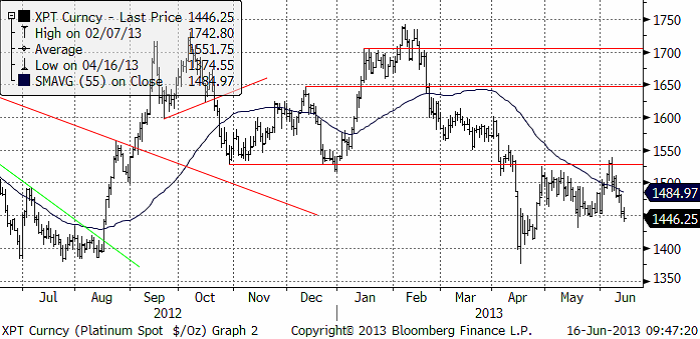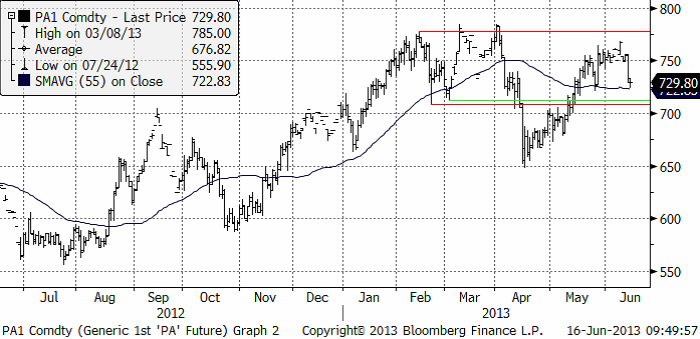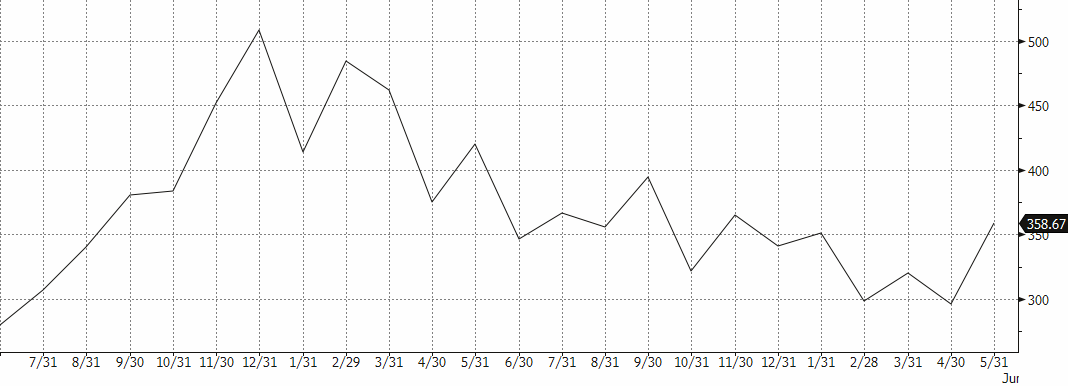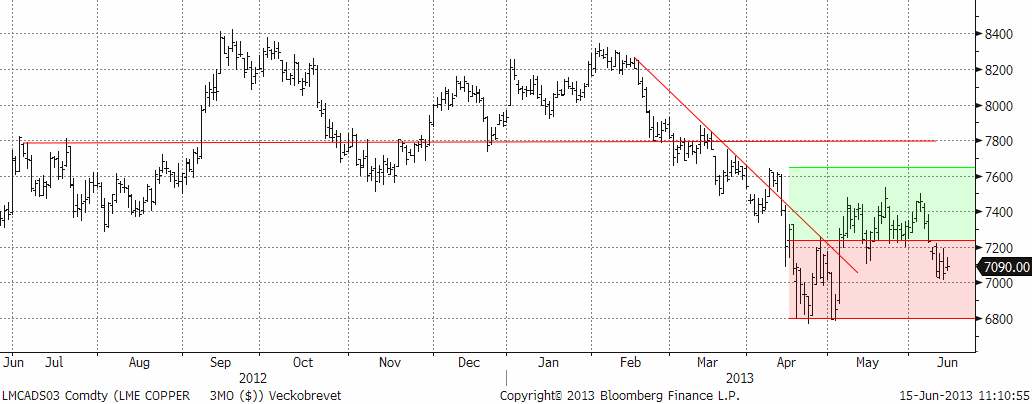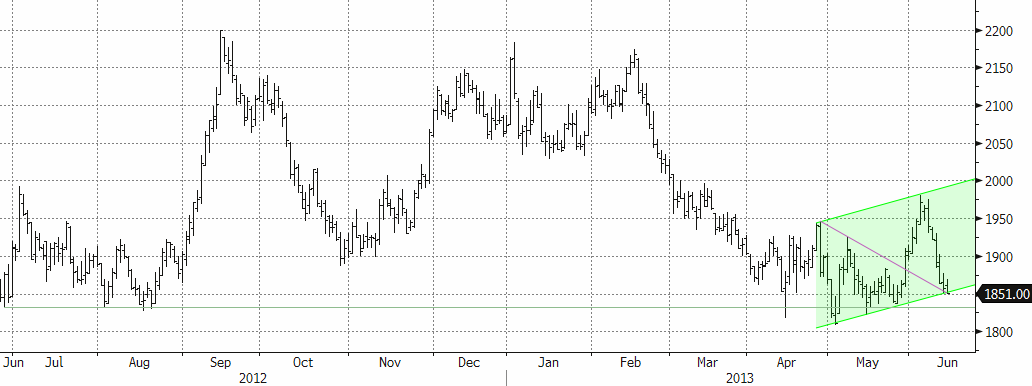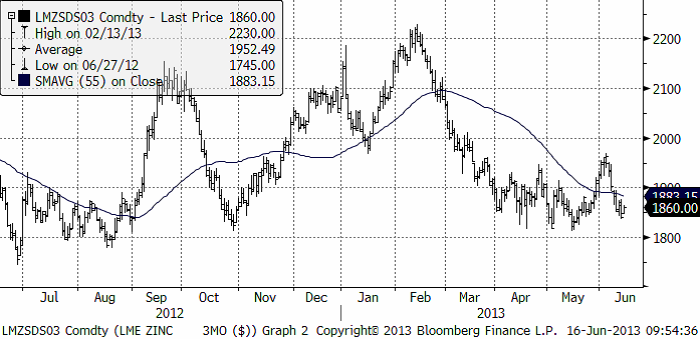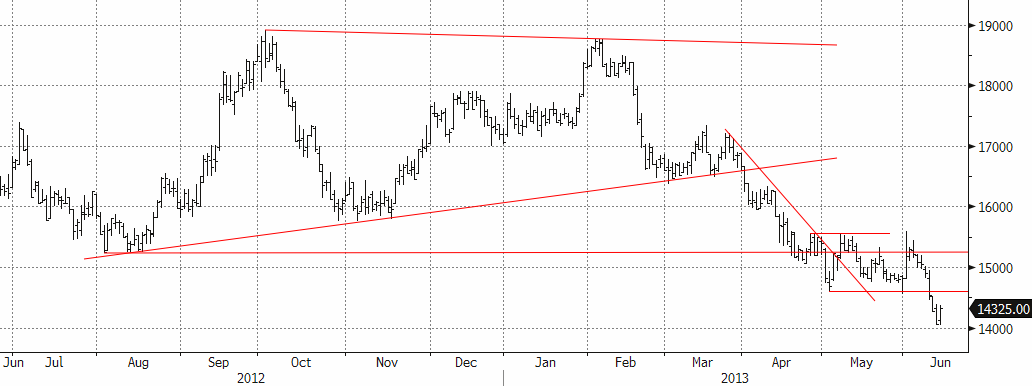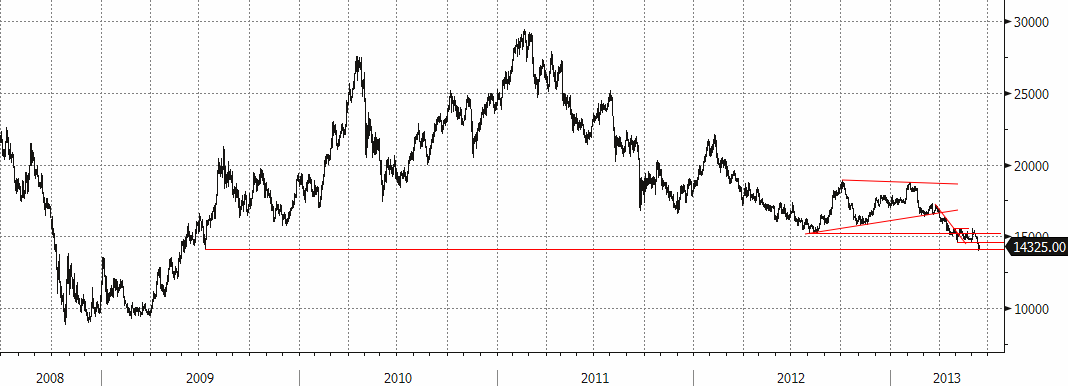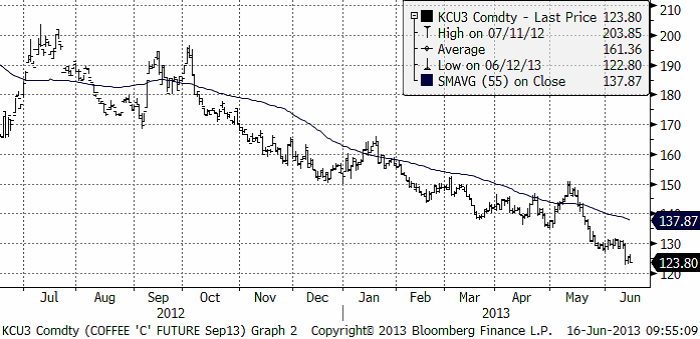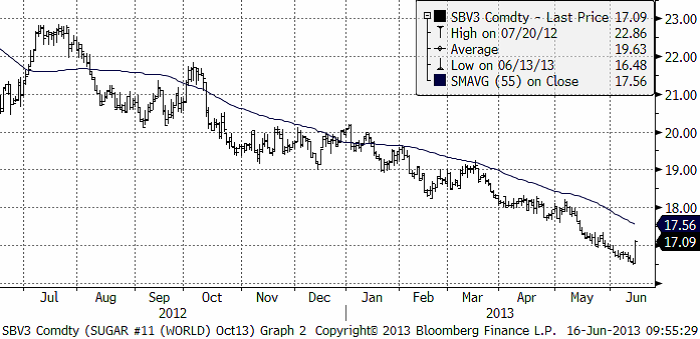Analys
SEB – Råvarukommentarer, 17 juni 2013

Rekommendationer
*) Avkastningen avser 1:1 råvarucertifikat där de ingår i rekommendationen. I den aktuella tabellen ovan har jag tagit prisförändringen den senaste veckan sedan det förra veckobrevet publicerades.
Inledning
Vi går från sälj till neutral rekommendation alla ädelmetaller i det här veckobrevet. USDA har rapporterat om produktion och efterfrågan på spannmål. En stor del av det här veckobrevet handlar om det. Priserna på basmetaller är nedtryckta i det “fundamentala golvet” och kan vara köpvärda på längre sikt. Socker tvärvände uppåt i fredags, utan att vi kunnat hitta någon annan anledning än att när alla var sålda, fanns risken att priset skulle gå upp.
Råolja – Brent
Vi börjar nu närma oss det tredje kvartalet, som säsongsmässigt brukar vara en stark månad för oljepriset. I fredags bröt priset upp genom motståndet på 105 dollar och steg då ögonblickligen med 30 cent och fortsatte sedan upp till över 106 dollar.
Lagren och lagerförändringarna i USA den senaste rapportveckan ser vi nedan, enligt Department of Energy och American Petroleum Institute.
Nedan ser vi amerikanska råoljelager enligt DOE i tusen fat. Den svarta kurvan är 2012 års lagernivåer vecka för vecka och den lilla röda linjen är 2013 års nivå.
Importen fortsätter att hålla sig under förra årets nivå.
Det är intressant att notera att antalet borriggar utanför OPEC har legat stabilt mellan 800 och 900 sedan 2010. Antalet borriggar i oljerika OPEC har däremot ökat från 250 till 427 under samma tid. Prognosen är att OPEC:s reservkapacitet ska öka betydligt de kommande åren, även om produktionen just nu är mindre än tidigare, t ex i Libyen, som producerar mindre än 1 miljon fat om dagen. Innan Kadaffi-regimen föll producerade landet 1.7 miljoner fat om dagen.
I borrigg-datat ser vi kanske en trendvändning, eftersom man i Mellanöstern kan utvinna olja till en kostnad betydligt under dagens marknadspris.
Vår vy är neutral till positiv. Det kan i det korta perspektivet komma en uppgång.
Elektricitet
Förra veckan slutade i baisse och den har fortsatt hela veckan. Tredje kvartalets terminskontrakt, som vi ser i kursgrafen nedan, föll ner från 40 euro per MWh till 37.58 vid stängning i fredags. Bakom ligger en fortsatt återhämtning av den hydrologiska balansen, där underskottet om 10 veckor av Markedskraft väntas visa på ett underskott mot det normala så här års på endast 1 TWh.
Hydrologisk balans har fortsatt att stiga, som vi ser i nedanstående diagram.
Utsläppsrätter har fortsatt att återhämta förlorad mark och har nu stigit till 4.70 euro per ton koldioxid. I april handlades rätterna som lägst till 2.46 euro för ”leverans” i december.
Priset har kommit ner så pass att det börjar bli intressant att köpa el, men rekommendationen blir än så länge ”neutral”.
Naturgas
Naturgaspriset har den senaste veckan konsoliderat sig kring 3.80 dollar per MMBtu.
Antalet borriggar i USA för gas har enligt Baker Hughes minskat till den lägsta nivån sedan 1995. Antalet var oförändrat på 354 riggar i veckan, samma som veckan innan.
IEA rapporterar att de två kärnreaktorer som står still vid San Onofre i Kalifornien kommer att ersättas med naturgas. Det är ännu ett tecken på att gasen tar marknadsandelar i USA. Baker Hughes Rig Count data visar att antalet borr-riggar för gas ligger kvar nära 18-årslägsta som noterades den 10 maj. Orsaken till detta ointresse är det låga priset och för att produktionen ökar ändå. EIA räknar med att år 2013 blir det sjätte året på raken med rekordproduktion av naturgas i USA.
Guld och Silver
Guldpriset har stabiliserat sig den senaste veckan. Jag väntade mig ett nytt prisfall, men det uteblev. Vi ser istället att en triangelformation har bildats. Formen på den, med en brantare motståndslinje (den övre) än den undre, talar för att utbrottet från triangeln blir uppåt, baserat på erfarenhet. När så många kommentatorer och ”analytiker” är negativa till guldets framtida prisutveckling, skulle det inte heller förvåna om priset rör sig i motsatt riktning, dvs uppåt. Vi väljer därför att kliva av våra korta positioner och vara neutrala.
Investerare fortsätter att likvidera sina innehav av Gold Spiders, som vi ser nedan.
Nedan ser vi kursdiagrammet för silver i dollar per troy ounce. Stödet på 22 dollar bröts i för en vecka sedan och det indikerade ett prisfall ner mot 20 dollar. Detta har ännu inte inträffat. Marknaden är förvånansvärt stark, trots allt. Vi ser att motståndslinjen ligger precis ovanför dagens kursnivå. Om investerarnas förtroende återvänder, kan motståndet brytas och vi få ett slut på den fallande pristrenden.
I det här läget, där vi huvudsakligen tror att trenden är nedåt, men vi inte är riktigt säkra, så väljer vi att gå över till neutral position.
Platina & Palladium
Platina föll tillbaka ordentligt i veckan som gick, vilket ökade värdet på BEAR PLATIN X4 S, som vi rekommenderat köp av. Priset har nu kommit ner en bit, men platina har fallit väsentligt mycket mindre än guld och silver. Kanske på goda grunder, men vi väljer i alla fall att gå över till neutral rekommendation.
Palladium föll kraftigt i torsdags. Prisfallet hejdades på samma nivå som prisfallet i slutet av maj bottnade på. Uppenbarligen finns det köpare som tycker att den nivån är svår att motstå. Uppgången från botten i april slutade lägre än toppnoteringarna i mars och april, vilket är ett svaghetstecken. Palladium ligger på en mycket högre nivå än de andra ädelmetallerna, om man tittar på historiska relationer. Trots att prisfallet kortsiktigt har hejdats, är den lite längre trenden försvagad. Jag tror att vi får se ”sidledes” rörelse den närmaste tiden, och då blir rekommendationen att inta neutral position. Vi går alltså ur BEAR PALLAD X4 S.
Basmetaller
Råvarorna gick åt olika håll. Det svårt att utläsa något entydigt mönster just nu. Eurodollarn är stark, vilket innebär svag dollar vilket brukar vara positivt för dollarnoterade råvaror. Oljan svarar på den faktorn, och i viss mån de som verkligen ska göra det, d.v.s. ädelmetallerna. Men också där är det blandat med uppgångar för guld och silver medan Platinametallerna faller tillbaka.
Det senare kan vara en effekt av deras karaktär av att delvis betraktas som industrimetaller. Nickel och aluminium drabbades av kraftiga prisfall, minus ca 4 %. Zink och koppar höll sig bättre med nedgångar kring 1,5 % – den senare understödd av produktionsstoppet vid Grassberggruvan i Indonesien. Förra helgens batteri av industridata från Kina med lägre import och export, investeringar, utlåning och investeringar – satte stämningsläget direkt på måndag morgon.
Koppar
Om vi ser på koppar isolerat, är egentligen nyhetsflödet ganska ”positivt” i den bemärkelsen att utbudet riskerar att påverkas negativt de kommande månaderna. Det finns risk att det blir ”tight”, åtminstone tillfälligt. Grassberggruvan deklarerade force majeure för alla kopparleveranser under veckan. Gruvan är, på order av den Indonesiska regeringen, stängd för översyn efter en rad dödsolyckor på senare tid. Ett jordskred tidigare under året vid den stora Binghamgruvan i Utah US, är stängd sedan flera månader. Bristen är inte lika stor på koppar som för några år sedan, men utbudsstörningarna riskerar att få effekt, om de blir långvariga. Kinas importsiffror från förra månaden (som kunde läsas på skärmarna måndag morgon) visar ett ökat intag av koppar. Delvis är det en eftersläpande säsongseffekt efter det kinesiska nyåret, men icke desto mindre en positiv information till marknaden. Det ryktas samtidigt att regeringen är ute och sonderar för att öka de strategiska inköpen (historiskt har Kina varit stor köpare när priset dippar under $7000). Som vi skrivit tidigare har vi haft kopparn under bevakning för att gå från neutral till köp. Tekniskt sett har vi bedömt förutsättningarna som goda för kortsiktig uppgång. Trots de senaste veckornas tveksamhet, tar vi fasta på indikationer att det negativa stämningsläget kring koppar håller på att svänga om. Som vi skrivit tidigare tyder mycket på att lagren i Kina har betats av, och att avmattningen av importen är relativt snart övergående (vilket veckans siffra tyder på – se graf).
Kinas kopparimport (1000-tals ton)
De två senaste veckornas svaga utveckling sätter kopparn i ett mer neutralt läge i en sidledes trend. Avvaktan kan nu vara på sin plats. Om priset faller under $7000, är det köpläge igen, framför allt om vi når nivåer kring $6800 igen.
Vi förväntar oss fortsatt hög volatilitet. Vår kortsiktiga bedömning talar för uppsidan och vi rekommenderar därför köp av BULL KOPPAR X2 S eller X4 S.
Aluminium
Priset har nu ”testat” stödnivåerna vid $1810-20 vid ett flertal tillfällen, och lyckats studsa upp. Det är ett styrketecken. Vi ser fysiska aktörer som går in och täcker in framtida konsumtion via terminsköp vid varje dipp. Tekniskt orienterade fonder har tidigare sålt vid varje uppställ. För två veckor sedan bröts mönstret. Istället började finansiella aktörer att köpa tillbaka kortpositioner i stora kvantiteter. Förra fredagens stängning över $1900, med ett bekräftat brott ur triangelformationen i kombination med starka Kinasiffror, gav förutsättningar för fortsatt uppgång på kort sikt, i första hand upp till $1950-nivån (vilket också materialiserades med råge). Veckans utveckling är ett tecken på att det är för tidigt att se den stora vändningen för aluminium. Lagren är för stora än så länge och det tar tid att ”beta av”. Vi ser ändå långsiktiga tecken på att marknaden dock succesivt håller på att bottna ur. Högkostnadsproducenterna, framför allt i Kina, förväntas minska utbudet (ännu mer) om priset långvarigt stannar på nuvarande nivåer. Den största aluminiumproducenten Chalco, annonserade i förra veckan att de stänger ytterligare produktionskapacitet motsvarande 380 tton.
Långsiktigt är nivån väldigt intressant för kontraktet Aluminium S (utan hävstång). Kortsiktigt är ett kontrakt med hävstång intressant, med potential inom trendkanalen.
Zink
Situationen för zink påminner om den för aluminium, både fundamentalt och tekniskt. Vi bedömer zinken som ”billig” ur ett kostnadsperspektiv och nuvarande nivåer är mycket intressanta på lite längre sikt (6-12 månader). I det perspektivet är Zink S (utan hävstång) att föredra.
Nickel
Nickel uppvisar förnyad svaghet. Priset bröt igenom stödet vid $14600, vilket lockade fram nya volymer och förnyat säljtryck. Priset nådde som lägst $14055, den lägsta nivån sedan juli 2009. Den relativa svagheten för nickel känns obefogad, och risken för de som har sålt på termin ökar. Det behövs inte mycket för att ”trigga” ännu ett s.k. short covering rally.
Trots väldigt goda efterfrågeutsikter på sikt, där den rostfria- och specialstålproduktionen förväntas öka med fortsatt utbyggnad av olje- och gasproduktion och specialstål till flygindustrin, ”lider” nickelmarknaden av ett överskott. Produktionstekniken av s.k. Nickel Pig Iron i Kina har utvecklats med s.k. Rotary Kiln Electric Furnaces (RKEF) teknik, vilken i genomsnitt sänker hela kostnadskurvan. Samtidigt får högkostnadsproducenterna i gruvledet problem på nuvarande nivåer. Vi har tidigare rapporterat om produktionsneddragningar i Australien, och det förväntas komma mer.
Effekten av RKEF-tekniken riskerar att flytta ner nivån där utbudsminskningarna verkligen får effekt. Priset har brutit viktiga stödnivåer, och vi får gå tillbaka till juli 2009 för att hitta lägre priser. I det perspektivet kommer nästa stora stödnivå in kring $14000. I veckan nådde vi nästa dit (14055 som lägst). Nivåerna är mycket attraktiva på 6-12 månaders sikt. I det perspektivet är Nickel S (utan hävstång) att föredra.
Nickel från juni 2012
Nickel från juni 2008
Kaffe
Kaffepriset tog ett steg ner för en vecka sedan och har sedan hållit sig stabilt. Priset börjar närma sig bottennivåer, men vi avvaktar till dess vi ser tecken på att trenden har vänt. Brasilianska kaffebönder rapporteras ha det allt värre, där många gör förluster på dagens priser.
Socker
Priset på socker tvärvände uppåt i fredags utan att vi kunde hitta någon bra fundamental anledning till detta. Det som nämns är att ”alla” var sålda terminer och att någon och sedan allt fler började stänga dessa. Rörelsen ser dock signifikant ut ur ett tekniskt perspektiv. Kanske är det så att marknaden börjar närma sig en botten.
Vi fortsätter med neutral rekommendation till dess bilden klarnar något.
[box]SEB Veckobrev Veckans råvarukommentar är producerat av SEB Merchant Banking och publiceras i samarbete och med tillstånd på Råvarumarknaden.se[/box]
Disclaimer
The information in this document has been compiled by SEB Merchant Banking, a division within Skandinaviska Enskilda Banken AB (publ) (“SEB”).
Opinions contained in this report represent the bank’s present opinion only and are subject to change without notice. All information contained in this report has been compiled in good faith from sources believed to be reliable. However, no representation or warranty, expressed or implied, is made with respect to the completeness or accuracy of its contents and the information is not to be relied upon as authoritative. Anyone considering taking actions based upon the content of this document is urged to base his or her investment decisions upon such investigations as he or she deems necessary. This document is being provided as information only, and no specific actions are being solicited as a result of it; to the extent permitted by law, no liability whatsoever is accepted for any direct or consequential loss arising from use of this document or its contents.
About SEB
SEB is a public company incorporated in Stockholm, Sweden, with limited liability. It is a participant at major Nordic and other European Regulated Markets and Multilateral Trading Facilities (as well as some non-European equivalent markets) for trading in financial instruments, such as markets operated by NASDAQ OMX, NYSE Euronext, London Stock Exchange, Deutsche Börse, Swiss Exchanges, Turquoise and Chi-X. SEB is authorized and regulated by Finansinspektionen in Sweden; it is authorized and subject to limited regulation by the Financial Services Authority for the conduct of designated investment business in the UK, and is subject to the provisions of relevant regulators in all other jurisdictions where SEB conducts operations. SEB Merchant Banking. All rights reserved.
Analys
Tightening fundamentals – bullish inventories from DOE

The latest weekly report from the US DOE showed a substantial drawdown across key petroleum categories, adding more upside potential to the fundamental picture.

Commercial crude inventories (excl. SPR) fell by 5.8 million barrels, bringing total inventories down to 415.1 million barrels. Now sitting 11% below the five-year seasonal norm and placed in the lowest 2015-2022 range (see picture below).
Product inventories also tightened further last week. Gasoline inventories declined by 2.1 million barrels, with reductions seen in both finished gasoline and blending components. Current gasoline levels are about 3% below the five-year average for this time of year.
Among products, the most notable move came in diesel, where inventories dropped by almost 4.1 million barrels, deepening the deficit to around 20% below seasonal norms – continuing to underscore the persistent supply tightness in diesel markets.
The only area of inventory growth was in propane/propylene, which posted a significant 5.1-million-barrel build and now stands 9% above the five-year average.
Total commercial petroleum inventories (crude plus refined products) declined by 4.2 million barrels on the week, reinforcing the overall tightening of US crude and products.


Analys
Bombs to ”ceasefire” in hours – Brent below $70

A classic case of “buy the rumor, sell the news” played out in oil markets, as Brent crude has dropped sharply – down nearly USD 10 per barrel since yesterday evening – following Iran’s retaliatory strike on a U.S. air base in Qatar. The immediate reaction was: “That was it?” The strike followed a carefully calibrated, non-escalatory playbook, avoiding direct threats to energy infrastructure or disruption of shipping through the Strait of Hormuz – thus calming worst-case fears.

After Monday morning’s sharp spike to USD 81.4 per barrel, triggered by the U.S. bombing of Iranian nuclear facilities, oil prices drifted sideways in anticipation of a potential Iranian response. That response came with advance warning and caused limited physical damage. Early this morning, both the U.S. President and Iranian state media announced a ceasefire, effectively placing a lid on the immediate conflict risk – at least for now.
As a result, Brent crude has now fallen by a total of USD 12 from Monday’s peak, currently trading around USD 69 per barrel.
Looking beyond geopolitics, the market will now shift its focus to the upcoming OPEC+ meeting in early July. Saudi Arabia’s decision to increase output earlier this year – despite falling prices – has drawn renewed attention considering recent developments. Some suggest this was a response to U.S. pressure to offset potential Iranian supply losses.
However, consensus is that the move was driven more by internal OPEC+ dynamics. After years of curbing production to support prices, Riyadh had grown frustrated with quota-busting by several members (notably Kazakhstan). With Saudi Arabia cutting up to 2 million barrels per day – roughly 2% of global supply – returns were diminishing, and the risk of losing market share was rising. The production increase is widely seen as an effort to reassert leadership and restore discipline within the group.
That said, the FT recently stated that, the Saudis remain wary of past missteps. In 2018, Riyadh ramped up output at Trump’s request ahead of Iran sanctions, only to see prices collapse when the U.S. granted broad waivers – triggering oversupply. Officials have reportedly made it clear they don’t intend to repeat that mistake.
The recent visit by President Trump to Saudi Arabia, which included agreements on AI, defense, and nuclear cooperation, suggests a broader strategic alignment. This has fueled speculation about a quiet “pump-for-politics” deal behind recent production moves.
Looking ahead, oil prices have now retraced the entire rally sparked by the June 13 Israel–Iran escalation. This retreat provides more political and policy space for both the U.S. and Saudi Arabia. Specifically, it makes it easier for Riyadh to scale back its three recent production hikes of 411,000 barrels each, potentially returning to more moderate increases of 137,000 barrels for August and September.
In short: with no major loss of Iranian supply to the market, OPEC+ – led by Saudi Arabia – no longer needs to compensate for a disruption that hasn’t materialized, especially not to please the U.S. at the cost of its own market strategy. As the Saudis themselves have signaled, they are unlikely to repeat previous mistakes.
Conclusion: With Brent now in the high USD 60s, buying oil looks fundamentally justified. The geopolitical premium has deflated, but tensions between Israel and Iran remain unresolved – and the risk of missteps and renewed escalation still lingers. In fact, even this morning, reports have emerged of renewed missile fire despite the declared “truce.” The path forward may be calmer – but it is far from stable.
Analys
A muted price reaction. Market looks relaxed, but it is still on edge waiting for what Iran will do

Brent crossed the 80-line this morning but quickly fell back assigning limited probability for Iran choosing to close the Strait of Hormuz. Brent traded in a range of USD 70.56 – 79.04/b last week as the market fluctuated between ”Iran wants a deal” and ”US is about to attack Iran”. At the end of the week though, Donald Trump managed to convince markets (and probably also Iran) that he would make a decision within two weeks. I.e. no imminent attack. Previously when when he has talked about ”making a decision within two weeks” he has often ended up doing nothing in the end. The oil market relaxed as a result and the week ended at USD 77.01/b which is just USD 6/b above the year to date average of USD 71/b.

Brent jumped to USD 81.4/b this morning, the highest since mid-January, but then quickly fell back to a current price of USD 78.2/b which is only up 1.5% versus the close on Friday. As such the market is pricing a fairly low probability that Iran will actually close the Strait of Hormuz. Probably because it will hurt Iranian oil exports as well as the global oil market.
It was however all smoke and mirrors. Deception. The US attacked Iran on Saturday. The attack involved 125 warplanes, submarines and surface warships and 14 bunker buster bombs were dropped on Iranian nuclear sites including Fordow, Natanz and Isfahan. In response the Iranian Parliament voted in support of closing the Strait of Hormuz where some 17 mb of crude and products is transported to the global market every day plus significant volumes of LNG. This is however merely an advise to the Supreme leader Ayatollah Ali Khamenei and the Supreme National Security Council which sits with the final and actual decision.
No supply of oil is lost yet. It is about the risk of Iran closing the Strait of Hormuz or not. So far not a single drop of oil supply has been lost to the global market. The price at the moment is all about the assessed risk of loss of supply. Will Iran choose to choke of the Strait of Hormuz or not? That is the big question. It would be painful for US consumers, for Donald Trump’s voter base, for the global economy but also for Iran and its population which relies on oil exports and income from selling oil out of that Strait as well. As such it is not a no-brainer choice for Iran to close the Strait for oil exports. And looking at the il price this morning it is clear that the oil market doesn’t assign a very high probability of it happening. It is however probably well within the capability of Iran to close the Strait off with rockets, mines, air-drones and possibly sea-drones. Just look at how Ukraine has been able to control and damage the Russian Black Sea fleet.
What to do about the highly enriched uranium which has gone missing? While the US and Israel can celebrate their destruction of Iranian nuclear facilities they are also scratching their heads over what to do with the lost Iranian nuclear material. Iran had 408 kg of highly enriched uranium (IAEA). Almost weapons grade. Enough for some 10 nuclear warheads. It seems to have been transported out of Fordow before the attack this weekend.
The market is still on edge. USD 80-something/b seems sensible while we wait. The oil market reaction to this weekend’s events is very muted so far. The market is still on edge awaiting what Iran will do. Because Iran will do something. But what and when? An oil price of 80-something seems like a sensible level until something do happen.
-

 Nyheter3 veckor sedan
Nyheter3 veckor sedanStor uppsida i Lappland Guldprospekterings aktie enligt analys
-

 Nyheter4 veckor sedan
Nyheter4 veckor sedanBrookfield ska bygga ett AI-datacenter på hela 750 MW i Strängnäs
-

 Nyheter3 veckor sedan
Nyheter3 veckor sedanSilverpriset släpar efter guldets utveckling, har mer uppsida
-

 Nyheter4 veckor sedan
Nyheter4 veckor sedanTradingfirman XTX Markets bygger datacenter i finska Kajana för 1 miljard euro
-

 Nyheter2 veckor sedan
Nyheter2 veckor sedanUppgången i oljepriset planade ut under helgen
-

 Nyheter2 veckor sedan
Nyheter2 veckor sedanLåga elpriser i sommar – men mellersta Sverige får en ökning
-

 Analys2 veckor sedan
Analys2 veckor sedanVery relaxed at USD 75/b. Risk barometer will likely fluctuate to higher levels with Brent into the 80ies or higher coming 2-3 weeks
-

 Nyheter1 vecka sedan
Nyheter1 vecka sedanMahvie Minerals växlar spår – satsar fullt ut på guld


